| View previous topic :: View next topic |
| Author |
Message |
cooltouch


Joined: 15 Jan 2009
Posts: 9097
Location: Houston, Texas
|
 Posted: Fri Mar 11, 2016 2:48 am Post subject: 200mm Lens Comparisons: 4 + a Ringer Posted: Fri Mar 11, 2016 2:48 am Post subject: 200mm Lens Comparisons: 4 + a Ringer |
 |
|
cooltouch wrote:
OK, I stated in the thread I started on the Canon New FD 200/2.8 that I would perform a test on the 200s I own. Those lenses include the aforementioned Canon nFD 200/2.8, a Canon nFD 200/4, a 200/4 Micro-Nikkor, and a Vivitar 200/3.5 (made by Komine). I also decided to toss in a "ringer," namely my Tamron SP 80-200mm f/2.8 LD, mostly because I bought it when I realized its resolution and contrast numbers very closely corresponded to the Nikkor 180/2.8 ED @ 200mm -- according to the published Modern Photography magazine numbes shown at adaptall-2.org.
It's been raining off-and-on all day today, so I decided to set up my tripod on my front porch, under an awning so the equipment wouldn't get wet. I managed to time things right, however, in that the rain decided to take a break for the test. I chose three subjects: the mailbox at the street in front of our house, a stop sign down the street, and an emblem on a pickup truck parked in the neighbor's driveway. Distance to the mailbox is approximately 8 meters, about 110 meters to the stop sign, and about 10 meters to the pickup truck.
First, I'll show full frame images of the three subjects, followed by combined crops at specified apertures. The camera used was a Sony NEX 7, set to ISO 100. It was tripod mounted for all exposures. The only PP performed on the images was translation from RAW to jpg format. All three of the full frame images were taken with the Canon 200/2.8 set to f/8 and then reduced in size for viewing here.
The three full-frames:
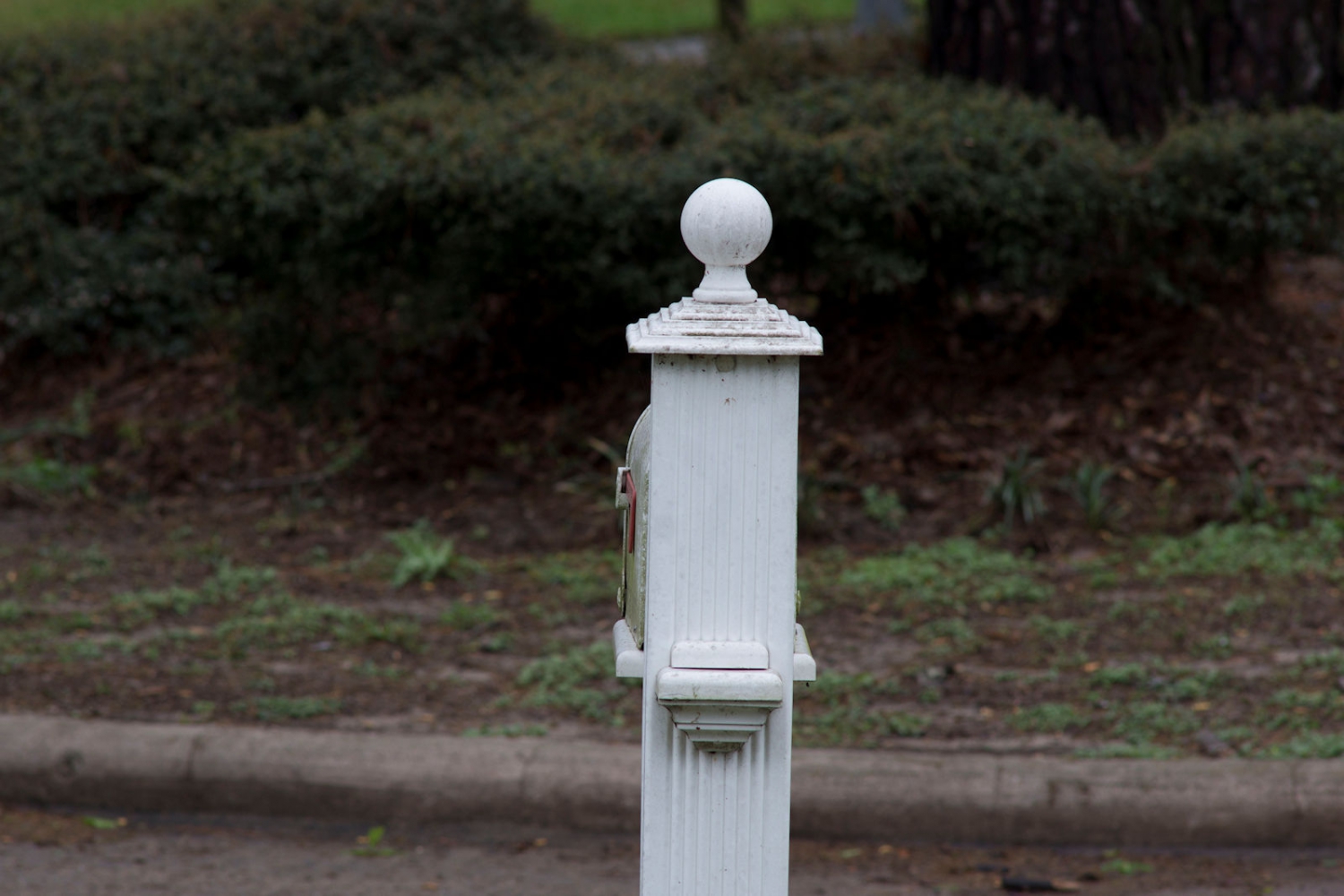

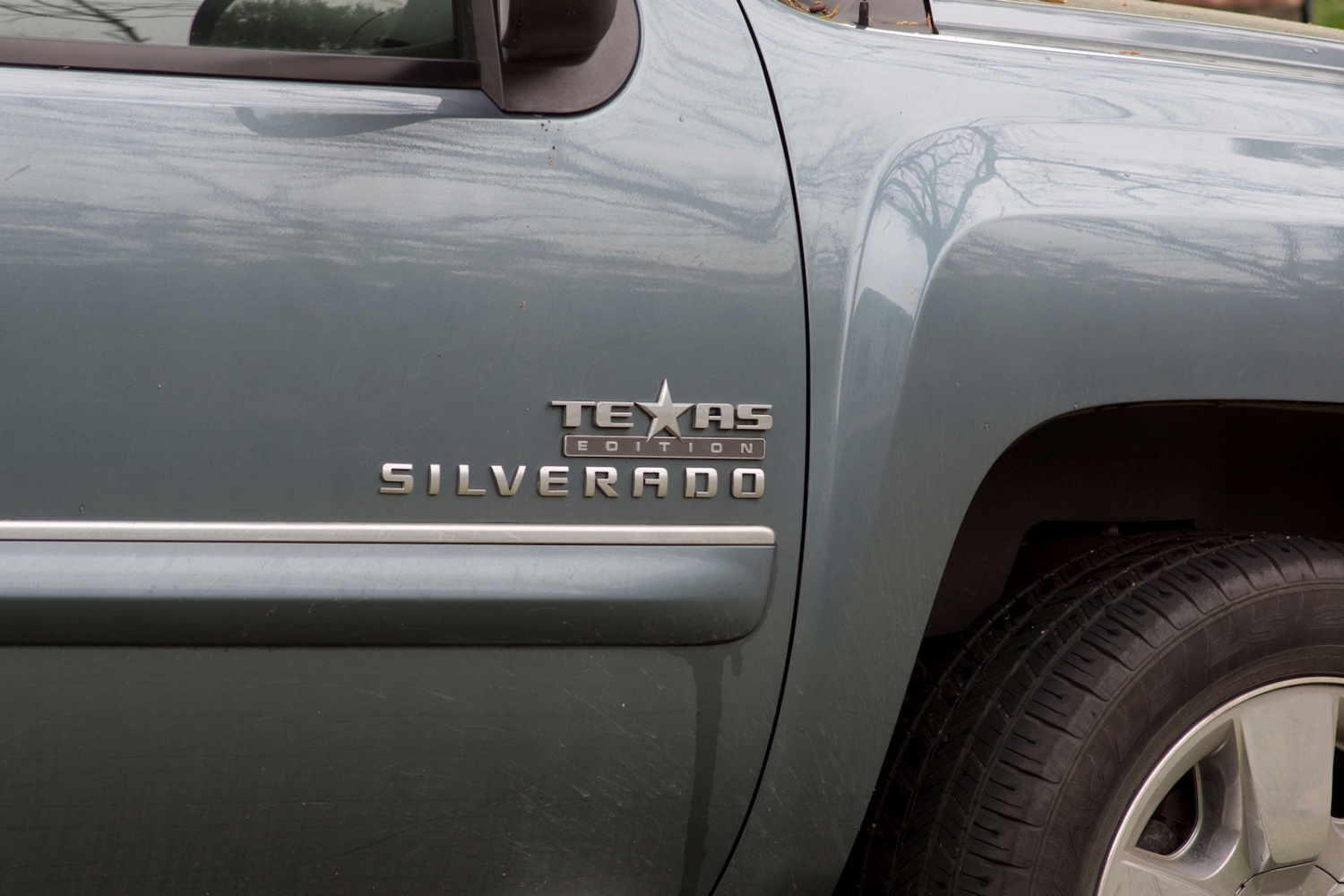
Okay, next I decided to show a few comparisons between the only two 200/2.8s here -- the Canon and the Tamron zoom set to 200mm. These are all 100% crops. The Canon is on the left, the Tamron on the right. In the thread on the Canon nFD 200/2.8 I mentioned how this lens is prone to pronounced CA. Well, here you can see it pretty clearly in the first shot especially. Gobs of the stuff. Note also how well controlled the Tamron is by comparison -- it's LD element is performing well. It's showing just a bit of blue fringing. To my eye, sharpness and contrast is just about identical with the two lenses.


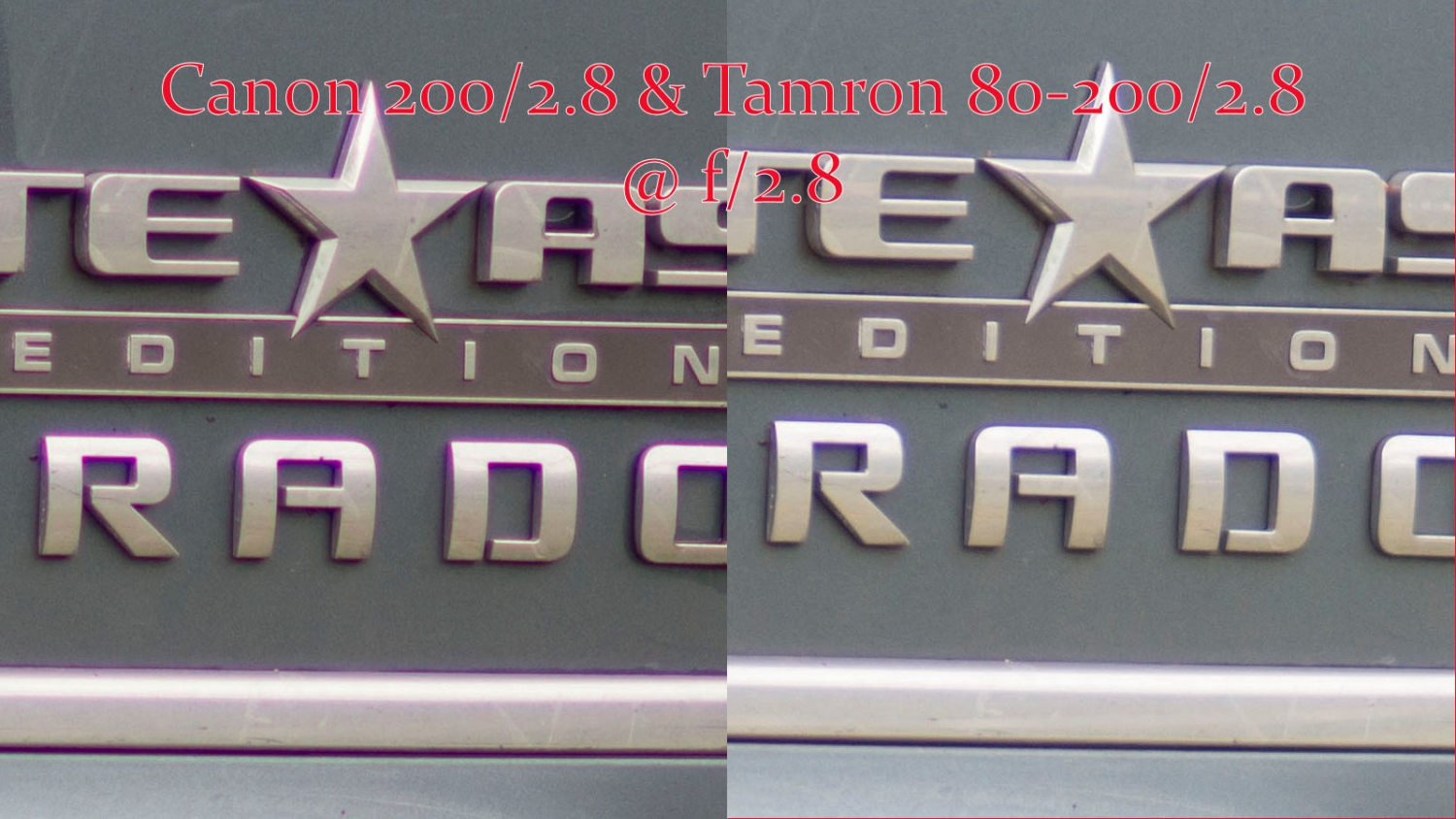
Next, we have comparisons showing all five optics together, all crops at 100%. I took these shots at f/4, f/8, and f/22 only.
At f/4, except the Vivitar, which I shot at f/3.5 by mistake, and was too lazy to go back and fix things.

At f/8:

At f/22:

Comments:
At f/2.8, the Canon and Tamron behave equivalently in terms of sharpness and contrast. The Tamron does show better control of CA than the Canon. Wide open, the Canon shows pronounced purple fringing, whereas the Tamron shoes blue fringing, but it's much less. It bears mentioning as well, that every subject I chose here was just about guaranteed to produce CA with any lens that tends toward it. Hard, contrasty lines, separating light and dark areas are the worst, I've found.
At f/4, all lenses except for the Vivitar are approximately equivalent in image appearance. The Vivitar reveals very strong blue CA and it was much softer at f/4 (well, f/3.5 actually) than the others. The Nikkor showed a trace of red CA, whereas the Canon 200/4 showed quite a bit of purple CA. The Canon 200/2.8 also showed some purple CA, but it was well-controlled. The Tamron showed a hint of blue fringing.
At f/8, there are differences, but they're more subtle. Again, the Vivitar is the standout. It still isn't as sharp as the others, but it exhibits much better color saturation than the others do. Regarding saturation, the Nikkor and Canon 200/2.8 are approximately equal with the next best saturation, followed by the Tamron, and trailed by the Canon 200/4. Regarding CA, I examined the border of the stop sign. The Vivitar shows a pronounced amount of green fringing and the Canon 200/2.8 also shows traces. The other three show negligible amounts, IMO. Sharpness is very close with all four lenses, but I'd have to give a slight edge to the Canon 200/4, followed by the Tamron 80-200/2.8, with the Nikkor 200 and Canon 200/2.8 bringing up the rear. The differences are very slight, however.
And finally at f/22, softness due to diffraction is becoming evident, except for -- surprise, surprise -- the Vivitar. Its sharpness is equal to that of the Micro-Nikkor 200mm, which one would expect to retain a good deal of sharpness even at small apertures, it being a macro lens and all. It appears that I got a bit of camera shake with the Canon 200/4, and I'd have to say that the Tamron zoom just edges out the Canon 200/2.8 at f/22. Really, I'm splitting hairs between all of them, they're all so close. I can detect no CA at this aperture.
So, my final judgements are that, at f/4 and beyond, with the exception of the Vivitar, the other four optics are essentially on par with each other. The differences are very minor. But here's the thing: I performed no post processing to these images of any sort. So with a bit of regular enhancement, I would be able to use any of those four lenses with excellent results. So I guess the bottom line is, if money is a concern, go for the nFD Canon 200/4 -- or equivalent. Chances are the Nikon 200/4, Minolta 200/4, Pentax 200/4, or Oly 200/4 will be just as good. But if you're shooting mirrorless and you're looking for something lightweight and compact, then I'd definitely give the nod to the Canon nFD. It's probably the smallest, lightest 200mm you're gonna find.
_________________
Michael
My Gear List: http://michaelmcbroom.com/photo/gear.html
My Gallery: http://michaelmcbroom.com/gallery3/index.php/
My Flickr Page: https://www.flickr.com/photos/11308754@N08/albums
My Music: https://soundcloud.com/michaelmcbroom/albums
My Blog: http://michaelmcbroom.com/blogistan/
Last edited by cooltouch on Fri Mar 11, 2016 2:17 pm; edited 1 time in total |
|
| Back to top |
|
 |
calvin83


Joined: 12 Apr 2009
Posts: 7554
Location: Hong Kong
|
 Posted: Fri Mar 11, 2016 6:10 am Post subject: Posted: Fri Mar 11, 2016 6:10 am Post subject: |
 |
|
calvin83 wrote:
The result is pretty much expected. If you can don't need the DOF and extra stop of light, slower lenses just works as good as the faster one.
P.S. The Tamron is a very well performer, it just works as good as the primes. 
_________________
https://lensfever.com/
https://www.instagram.com/_lens_fever/
The best lens is the one you have with you. |
|
| Back to top |
|
 |
TrueLoveOne


Joined: 30 Sep 2012
Posts: 1840
Location: Netherlands
Expire: 2013-12-24
|
 Posted: Fri Mar 11, 2016 6:25 am Post subject: Posted: Fri Mar 11, 2016 6:25 am Post subject: |
 |
|
TrueLoveOne wrote:
I am a bit surprised about how well the Tamron performs against some highly regarded optics! That is a good lens.
Nice test, thanks for sharing!
Cheers, René.
_________________
My Flickr photostream: http://www.flickr.com/photos/chantalrene/
Sony A7, Canon 5D mkII, Minolta 7D + RD3000 and some more.....
Minolta and Konica collector.... slowly selling all the other stuff! |
|
| Back to top |
|
 |
anktonio


Joined: 20 Oct 2012
Posts: 219
Location: Spain
Expire: 2017-02-22
|
 Posted: Fri Mar 11, 2016 7:52 am Post subject: Posted: Fri Mar 11, 2016 7:52 am Post subject: |
 |
|
anktonio wrote:
Great comparison and comments. I like more these real life comparative than the DxOMark.
Thank you very much for sharing.
Happy shots! |
|
| Back to top |
|
 |
stevemark

Joined: 29 Apr 2011
Posts: 3754
Location: Switzerland
|
 Posted: Fri Mar 11, 2016 1:56 pm Post subject: Re: 200mm Lens Comparisons: 4 + a Ringer Posted: Fri Mar 11, 2016 1:56 pm Post subject: Re: 200mm Lens Comparisons: 4 + a Ringer |
 |
|
stevemark wrote:
| cooltouch wrote: |
OK, I stated in the thread I started on the Canon New FD 200/2.8 that I would perform a test on the 200s I own.
...
So, my final judgements are that, beyond f/4, with the exception of the Vivitar, the other four optics are essentially on par with each other. The differences are very minor. But here's the thing: I performed no post processing to these images of any sort. So with a bit of regular enhancement, I would be able to use any of those four lenses with excellent results. So I guess the bottom line is, if money is a concern, go for the nFD Canon 200/4 -- or equivalent. Chances are the Nikon 200/4, Minolta 200/4, Pentax 200/4, or Oly 200/4 will be just as good. But if you're shooting mirrorless and you're looking for something lightweight and compact, then I'd definitely give the nod to the Canon nFD. It's probably the smallest, lightest 200mm you're gonna find. |
I have done similar tests on 24MP FF, and came essentialy to the same conclusions.
Canon FD 2.8/200 SSC
Canon nFD 2.8/200 IF
Canon nFD 4/200 IF
Canon nFD 4/200 Macro
Konica Hexanon 3.5/200
Konica Hexanon 4/200
Konica Hexar 4/200 (a huge & heavy beast, > 800g)
Minolta MC 3.5/200 (MC-I, MC-II, MC-X)
Minolta MD 2.8/200 (MD-II and MD-III)
Minolta MC & MD 4/200 (long version)
Minolta MD 4/200 (short version)
Nikkor Ai 4/200
* Generally, the f2.8 lenses have slightly stronger CAs and slightly less resolution than their f4 counterparts
* The much older Minolta 3.5/200mm design (from the 1960ties) is a bit weaker / lower contrast than most others
* The Hexanon 3.5/200 has blueish-yellow CAs (instead of magenta-grees) and also is weaker than most other designs mentioned above
* The Minolta MC/MD 4/200 (longer version) has the best corner resolution of al the lenses above
Stephan
_________________
www.artaphot.ch |
|
| Back to top |
|
 |
cooltouch


Joined: 15 Jan 2009
Posts: 9097
Location: Houston, Texas
|
 Posted: Fri Mar 11, 2016 2:13 pm Post subject: Posted: Fri Mar 11, 2016 2:13 pm Post subject: |
 |
|
cooltouch wrote:
Thanks for you feedback, Stephan. You have a nice selection of premium 200mm lenses! It's good to see that your results essentially agree with mine.
Because I was using an APS-C cropy body camera, I did not comment on corner sharpness, since it wouldn't be appropriate. Other than your comment that the Minolta was the best vis a vis corner sharpness, how would you say that most of the lenses you tested performed in this regard? Was there a lot of variability, or not?
_________________
Michael
My Gear List: http://michaelmcbroom.com/photo/gear.html
My Gallery: http://michaelmcbroom.com/gallery3/index.php/
My Flickr Page: https://www.flickr.com/photos/11308754@N08/albums
My Music: https://soundcloud.com/michaelmcbroom/albums
My Blog: http://michaelmcbroom.com/blogistan/ |
|
| Back to top |
|
 |
stevemark

Joined: 29 Apr 2011
Posts: 3754
Location: Switzerland
|
 Posted: Fri Mar 11, 2016 2:45 pm Post subject: Posted: Fri Mar 11, 2016 2:45 pm Post subject: |
 |
|
stevemark wrote:
There are differences in corner sharpness on 24MP FF.
The MC/MD 4/200 (1st version) clearly has more details than all the others mentioned here (only the AF 2.8/200 APO being visibly better). But before saying more, i'd have to check the original test images again, otherwise i might spread some nonsense 
Stephan
_________________
www.artaphot.ch |
|
| Back to top |
|
 |
iangreenhalgh1


Joined: 18 Mar 2011
Posts: 15685
Expire: 2014-01-07
|
 Posted: Fri Mar 11, 2016 7:39 pm Post subject: Re: 200mm Lens Comparisons: 4 + a Ringer Posted: Fri Mar 11, 2016 7:39 pm Post subject: Re: 200mm Lens Comparisons: 4 + a Ringer |
 |
|
iangreenhalgh1 wrote:
| stevemark wrote: |
* The Hexanon 3.5/200 has blueish-yellow CAs (instead of magenta-grees) and also is weaker than most other designs mentioned above
|
Something wrong there then, I've had three copies, early, middle and late production, kept two of them. It's the best 200mm for 35mm SLR I've tried.
_________________
I don't care who designed it, who made it or what country it comes from - I just enjoy using it! |
|
| Back to top |
|
 |
stevemark

Joined: 29 Apr 2011
Posts: 3754
Location: Switzerland
|
 Posted: Fri Mar 11, 2016 9:40 pm Post subject: Re: 200mm Lens Comparisons: 4 + a Ringer Posted: Fri Mar 11, 2016 9:40 pm Post subject: Re: 200mm Lens Comparisons: 4 + a Ringer |
 |
|
stevemark wrote:
| iangreenhalgh1 wrote: |
| stevemark wrote: |
* The Hexanon 3.5/200 has blueish-yellow CAs (instead of magenta-grees) and also is weaker than most other designs mentioned above
|
Something wrong there then, I've had three copies, early, middle and late production, kept two of them. It's the best 200mm for 35mm SLR I've tried. |
That's interesting! To make things clearer ...
* Could you provide us with some images (100% crops from the center and the corners) from a good 200mm f3.5 Hexanon?
* Against which other 200mm lenses did you compare it?
* Which camera did you use to compare them?
I'm sure quite a few people will be interested!
Stephan
_________________
www.artaphot.ch |
|
| Back to top |
|
 |
uhoh7

Joined: 24 Nov 2010
Posts: 1300
Location: Idaho, USA
|
 Posted: Sat Mar 12, 2016 5:03 am Post subject: Posted: Sat Mar 12, 2016 5:03 am Post subject: |
 |
|
uhoh7 wrote:
Michael, I can never tell a thing at that range. It's amazing how you can really sort long lenses with an infinity shot.
Here's my nikkor 180/2.8 AIS ED:
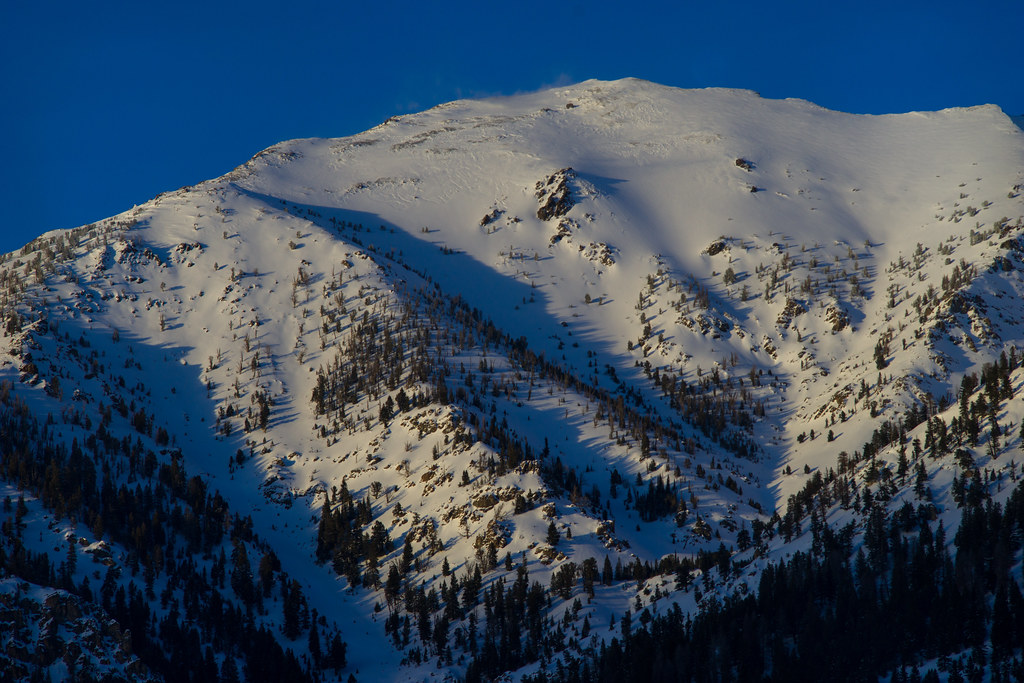
North Wind by unoh7, on Flickr
It was windy, so not perfect, but if you peep a shot like this the smallest variations in performance are pretty easy to see.
_________________
Making MFlenses safe for the letter *L*  |
|
| Back to top |
|
 |
cooltouch


Joined: 15 Jan 2009
Posts: 9097
Location: Houston, Texas
|
 Posted: Sat Mar 12, 2016 5:41 am Post subject: Posted: Sat Mar 12, 2016 5:41 am Post subject: |
 |
|
cooltouch wrote:
Hey uhoh, if you're referring to the stop sign shot as an infinity shot, I'd have to say "not quite." I used both the NEX's focus peaking and 11.7x magnification to insure best focus with each lens.
That's a magnificent shot you took with your Nikkor 180 ED. I really like that little tuft of snow flurry clearly visible on the crest. I would have loved to include a Nikkor 180 ED in this comparison, but I don't own one anymore. Plus, as mentioned previously, I included the Tamron zoom since its MP numbers @200mm so closely matched those of the Nikkor 180. I wouldn't mind, though, for my own personal edification, doing a head to head test against those two lenses, just to see if those MP numbers really hold up.
I've posted this image before, but I can't resist doing it again, probably my favorite image taken with h my old Nikkor 180 ED:

That shot was taken with an F2 and Fujichrome 100 film back in about 1992. Now, what I've always liked so much about that shot, besides Garfield of course, is the fact that you can count the rivets in that A6's canopy and fuselage and practically read the fine print on the ejection seats. A film shot that rivals a good digital one, in my view.
_________________
Michael
My Gear List: http://michaelmcbroom.com/photo/gear.html
My Gallery: http://michaelmcbroom.com/gallery3/index.php/
My Flickr Page: https://www.flickr.com/photos/11308754@N08/albums
My Music: https://soundcloud.com/michaelmcbroom/albums
My Blog: http://michaelmcbroom.com/blogistan/ |
|
| Back to top |
|
 |
Koen Nhz


Joined: 07 Jul 2011
Posts: 84
Location: Antwerp, Belgium
|
 Posted: Wed Mar 16, 2016 2:42 pm Post subject: Posted: Wed Mar 16, 2016 2:42 pm Post subject: |
 |
|
Koen Nhz wrote:
Thank you cooltouch for this very informative test!
You got me kind of 'scared' though, I had just won a local auction for the FD 200mm 1:2.8 S.S.C. when you posted this, and I already had an FD 80-200 1:4 S.S.C. (non-L), so I thought this new lens wouldn't stay very long..
But i have to say that I think I like it a lot after my first test, I admit, the (nowadays) very cheap 80-200 also has much less CA than the prime, but the prime seems much sharper to me (but the �19 zoom might have a problem at 200mm, it's very very sharp at 80-135mm imo)
Small album withe the 80-200 f/4: https://flic.kr/s/aHskw4K5Yi
These are 2 full resolution unedited (except for the copyright) ooc jpg's from the 200mm f/2.8 prime, first wide open, second f/4:
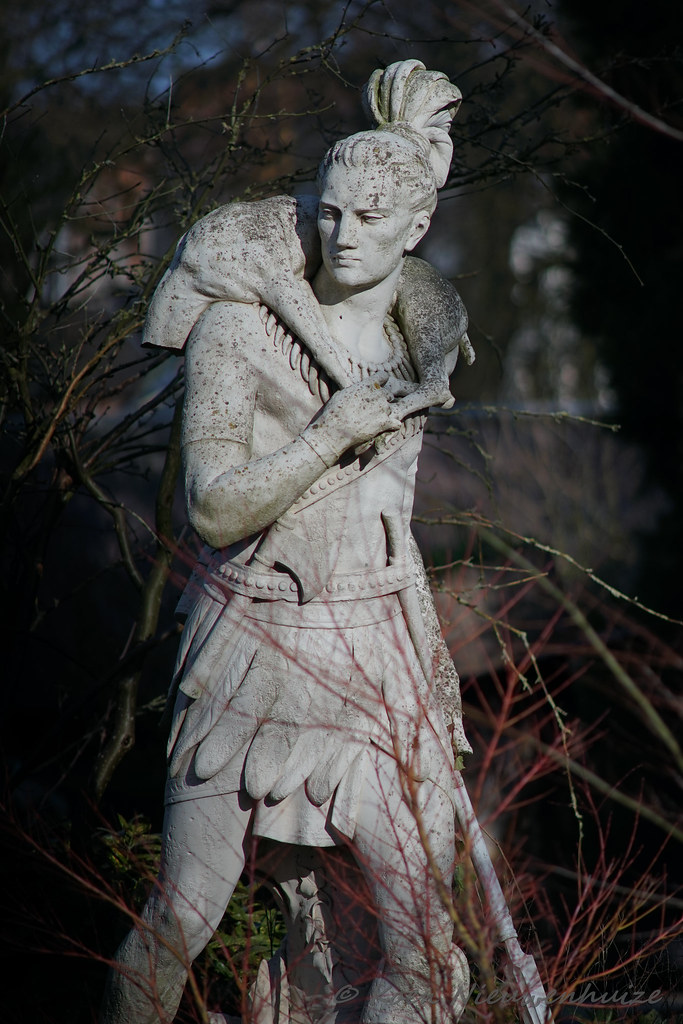
24Mp: DSC00533_f28_copyright by Koen Nieuwenhuize, on Flickr

24 Mp: DSC00534__f4_copyright by Koen Nieuwenhuize, on Flickr
You can see the CA, it clears up a bit on stopping down, but not all of it, this lens seems to have LoCA and LaCA at the same time wich seem to amplify each other in some situations, but most of the time it seems just fine to me with a lovely rendering and great contrast, resolution and bokeh.
A small album from the first day with it: https://flic.kr/s/aHskwi7Tgi
And a couple of samples (#5 is stopped down to f/4 or f/5.6, the rest is wide open I think):
#1

#2

#3

#4

#5

#6

#7

#8
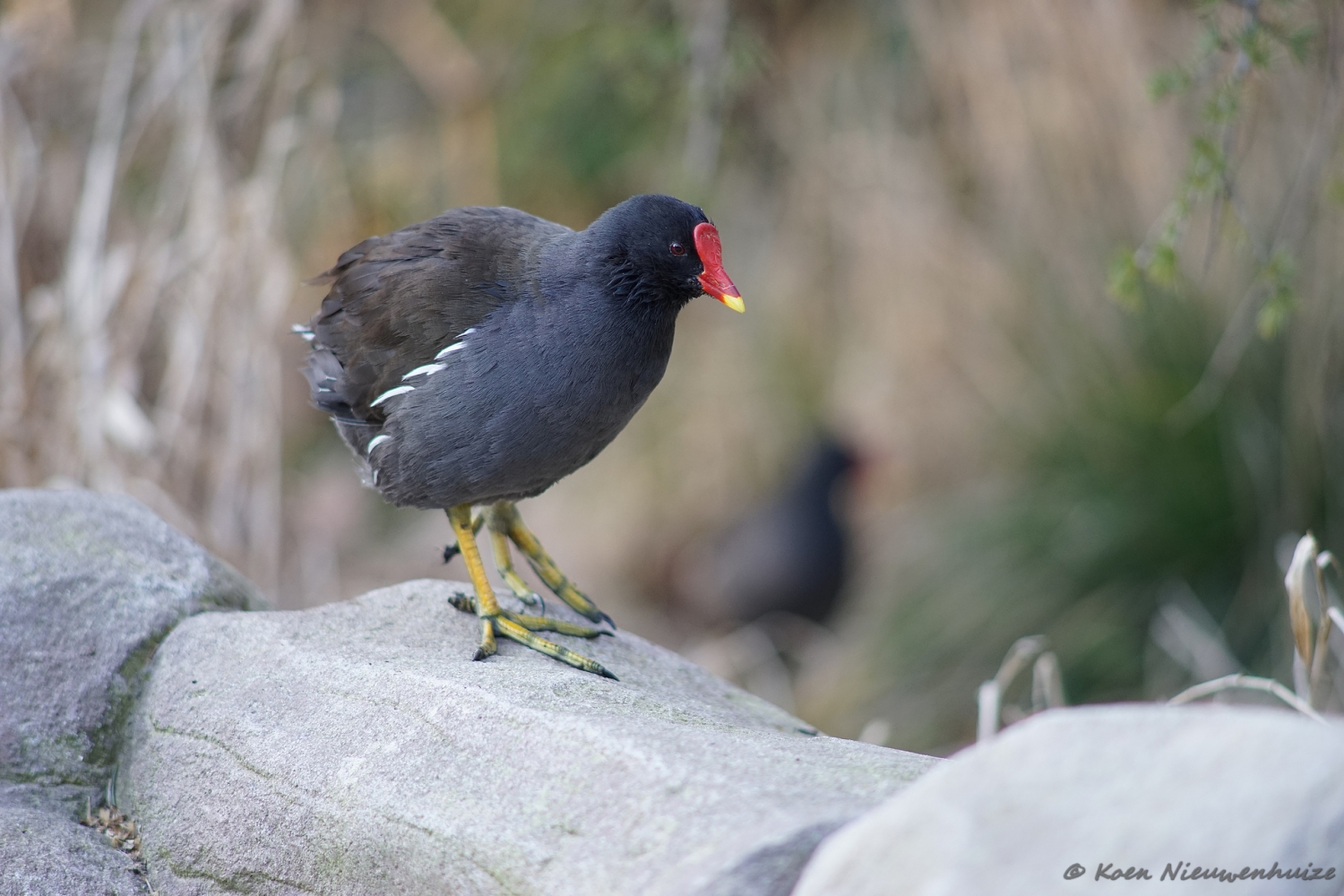
#9 this one is with the Canon FD extender 2x-B and I think the lens was wide open
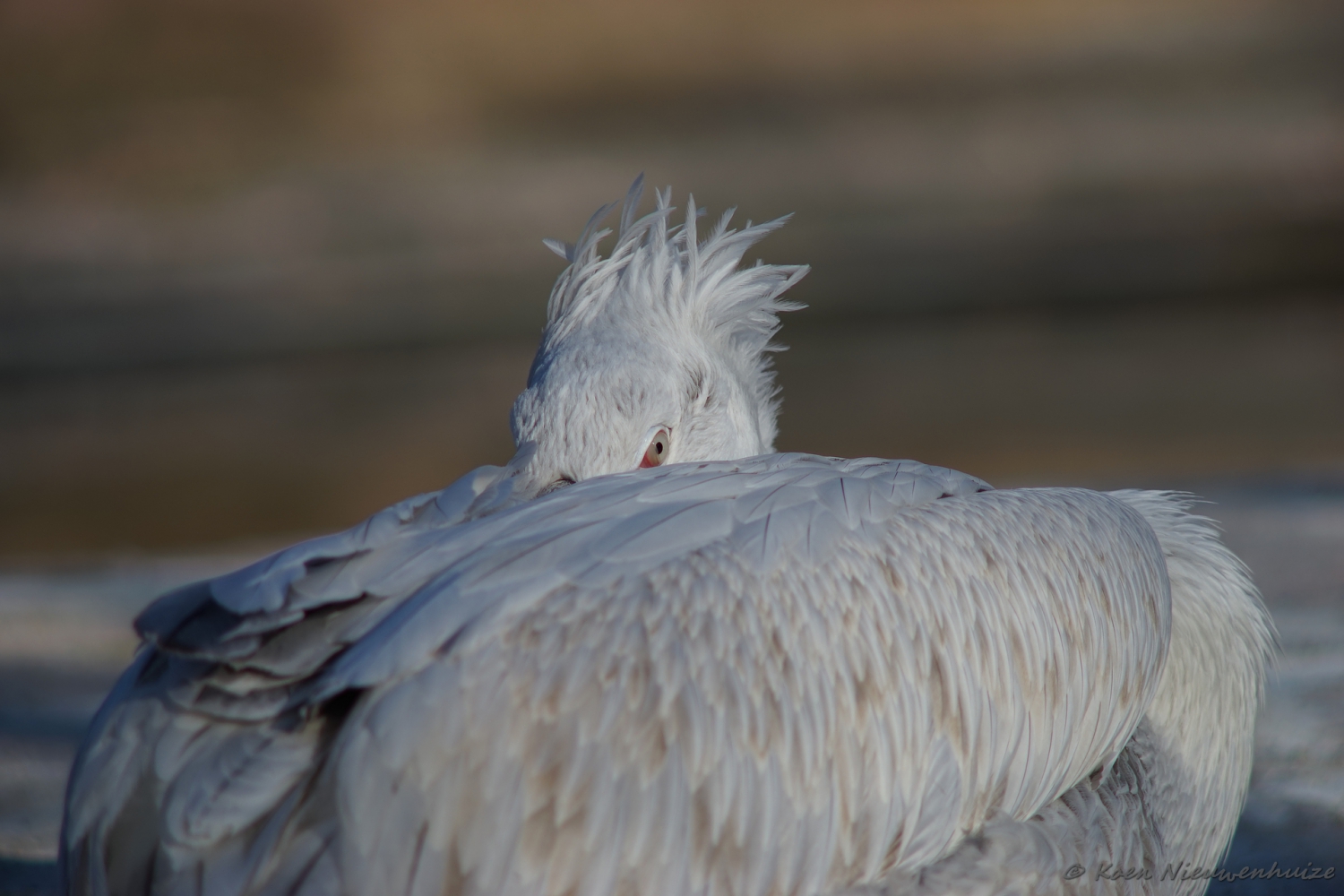
_________________
Sony α7, 28-70 | Minolta Rokkor 58 1.2 | CZ 35 2.8, 50 1.7, 135 2.8 | Canon 40D, nFD 20 2.8, 70-210 4, 300 4 L, FD SSC: 24 2.8, 35 2.8 TS, 50 3.5 Macro, 55 1.2 ASPH, 100 2.8, 80-200 4, 200 2.8, 500 8 Reflex | Vivitar S1 90 2.5 | Nikkor 105 1.8 | Takumar 50 1.4, 55 1.8, 135 2.5 & 3.5 | Tair 300 4.5 | ... |
|
| Back to top |
|
 |
WNG555


Joined: 18 Dec 2014
Posts: 784
Location: Arrid-Zone-A, USA
|
 Posted: Wed Mar 16, 2016 3:35 pm Post subject: Posted: Wed Mar 16, 2016 3:35 pm Post subject: |
 |
|
WNG555 wrote:

Remarkably good FD 200 f/2.8. The shot of the workers has a lot of 'pop'. I wish my AT-X 80-200 f/2.8 SD could do so well.
_________________
"The eyes are useless when the mind is blind."
Sony ILCE-6000, SELP1650, SEL1855, SEL55210, SEL5018. Sigma 19/30/60mm f2.8 EX DN Art.
Rokinon 8mm f3.5 Fish-Eye, 14mm f2.8 IF ED UMC. Samyang 12mm f2.8 ED AS NCS Fish-Eye.
And a bunch of Manual-Focus Lenses
My Flickr |
|
| Back to top |
|
 |
Koen Nhz


Joined: 07 Jul 2011
Posts: 84
Location: Antwerp, Belgium
|
 Posted: Wed Mar 16, 2016 3:46 pm Post subject: Posted: Wed Mar 16, 2016 3:46 pm Post subject: |
 |
|
Koen Nhz wrote:
Thank you!
I think this lens is best at longer focus distances, where it can give great pop indeed, it seems to give quite good "3D" feeling to me which I find one of the most important things in rendering.
At MFD, which isn't very close at 1.8m anyway, the CA gets a bit worse and sharpness is reduced a bit too.
_________________
Sony α7, 28-70 | Minolta Rokkor 58 1.2 | CZ 35 2.8, 50 1.7, 135 2.8 | Canon 40D, nFD 20 2.8, 70-210 4, 300 4 L, FD SSC: 24 2.8, 35 2.8 TS, 50 3.5 Macro, 55 1.2 ASPH, 100 2.8, 80-200 4, 200 2.8, 500 8 Reflex | Vivitar S1 90 2.5 | Nikkor 105 1.8 | Takumar 50 1.4, 55 1.8, 135 2.5 & 3.5 | Tair 300 4.5 | ... |
|
| Back to top |
|
 |
Gerald


Joined: 25 Mar 2014
Posts: 1196
Location: Brazil
|
 Posted: Wed Mar 16, 2016 5:51 pm Post subject: Re: 200mm Lens Comparisons: 4 + a Ringer Posted: Wed Mar 16, 2016 5:51 pm Post subject: Re: 200mm Lens Comparisons: 4 + a Ringer |
 |
|
Gerald wrote:
| cooltouch wrote: |
| OK, I stated in the thread I started on the Canon New FD 200/2.8 that I would perform a test on the 200s I own. |
Interesting and very well-conducted test, Michael!
I was surprised by the high level of longitudinal CA of the Canon 200mm F2.8. In spite of this, the resolution is very good, which shows that the Canon optical designers achieved a good balance of the residual aberrations.
We photographers (myself included) often have a romantic view of telephoto lenses, these "wonderful optical instruments that allow shooting things inaccessible to normal or wide-angle lenses." Nonetheless, my personal experience with telephoto lenses is that the longer the focal length, the more difficult it is to find good opportunities to use them. Maybe we should call the telephoto lens as "narrow angle lens" since it gives a better idea of how a telephoto lens works as a photographic tool… 
I have a CZJ 200mm F2.8 and a few CZJ 180mm F2.8, but I confess I was never very excited by these focal lengths when used with 35mm cameras. On a 6x6 camera a 180mm F2.8 lens is another history. I also understand perfectly well why the 70-200mm F2.8 zoom lens is so popular among professionals. It is much more versatile than a 200mm prime lens. Unfortunately a modern 70-200mm F2.8 is expensive and cumbersome. 
I would like to show how CZJ Sonnar 200mm F2.8 performs, and in particular what are the levels of longitudinal and chromatic aberration of that Sonnar lens. Test photos are of foliage of a tree against a strong back light. This is a situation in which any chromatic aberration of a lens becomes readily apparent.
The red squares show the regions from where the 100% crops were extracted.
As it is well known, there are two basic types of chromatic aberration, the longitudinal and the lateral CA. The LoCA is uniform across the field. Its effect can be considerably reduced by stopping down. For a good lens, one or two stops should be sufficient to make the LoCA negligible. In contrast, the lateral CA, LaCA, does not show in the very center of the field, but it is increasingly visible as we move away from the center toward the edges. The LaCA does not diminish with stopping down, but luckily it can be eliminated with PP in most cases.
In the photos below, the LoCA manifests as a bluish veil over the dark parts of pictures. Note in particular how the LoCA reduces the contrast of the black thin branches.
The LaCA is visible as fringes around dark areas. The LaCA is more noticeable for small apertures, when Loca becomes negligible. For large apertures, Loca is predominant everywhere, including at the edges.
Full image to evaluate CA in the center:


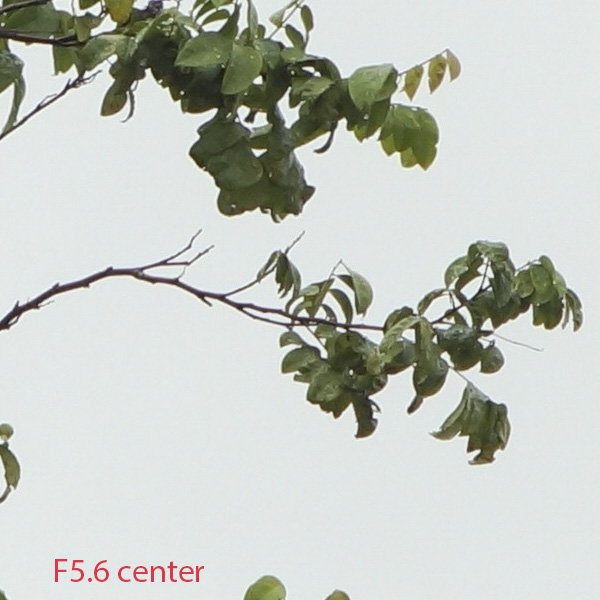

Full image to evaluate CA at the corner:



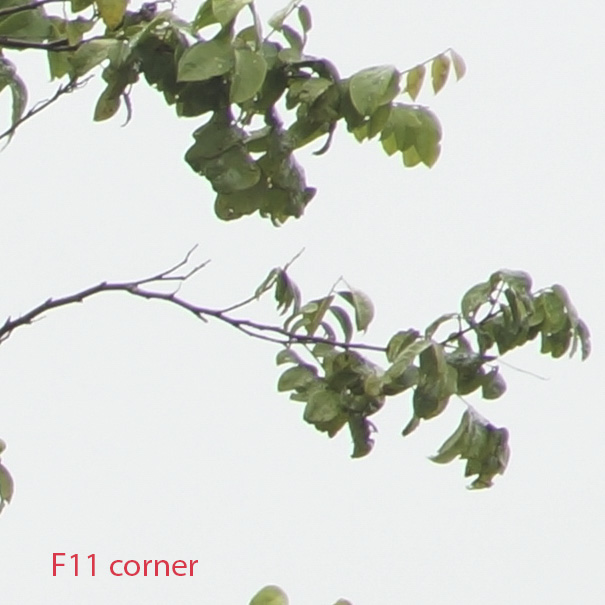
Now, bigger magnification to make LaCA more evident. The halos are due internal camera JPEG processing.
300% corner crop at F11:

LaCA at F11 removed by post-processing - 100% crop

As a final comment, in my opinion the CZJ Sonnar 200mm F2.8 has a lower level of LaCA than the Nikkor 180mm F2.8 ED, despite Carl Zeiss Jena have never claimed the use of special low-dispersion glass in its lenses.
_________________
If raindrops were perfect lenses, the rainbow did not exist. |
|
| Back to top |
|
 |
iangreenhalgh1


Joined: 18 Mar 2011
Posts: 15685
Expire: 2014-01-07
|
 Posted: Wed Mar 16, 2016 5:56 pm Post subject: Re: 200mm Lens Comparisons: 4 + a Ringer Posted: Wed Mar 16, 2016 5:56 pm Post subject: Re: 200mm Lens Comparisons: 4 + a Ringer |
 |
|
iangreenhalgh1 wrote:
| stevemark wrote: |
| iangreenhalgh1 wrote: |
| stevemark wrote: |
* The Hexanon 3.5/200 has blueish-yellow CAs (instead of magenta-grees) and also is weaker than most other designs mentioned above
|
Something wrong there then, I've had three copies, early, middle and late production, kept two of them. It's the best 200mm for 35mm SLR I've tried. |
That's interesting! To make things clearer ...
* Could you provide us with some images (100% crops from the center and the corners) from a good 200mm f3.5 Hexanon?
* Against which other 200mm lenses did you compare it?
* Which camera did you use to compare them?
I'm sure quite a few people will be interested!
Stephan |
Comparing lenses directly is a waste of time imho, a lens can stand (or fall) on it's own merits.
_________________
I don't care who designed it, who made it or what country it comes from - I just enjoy using it! |
|
| Back to top |
|
 |
Koen Nhz


Joined: 07 Jul 2011
Posts: 84
Location: Antwerp, Belgium
|
 Posted: Wed Mar 16, 2016 6:15 pm Post subject: Re: 200mm Lens Comparisons: 4 + a Ringer Posted: Wed Mar 16, 2016 6:15 pm Post subject: Re: 200mm Lens Comparisons: 4 + a Ringer |
 |
|
Koen Nhz wrote:
| Gerald wrote: |
| As a final comment, in my opinion the CZJ Sonnar 200mm F2.8 has a lower level of LaCA than the Nikkor 180mm F2.8 ED, despite Carl Zeiss Jena have never claimed the use of special low-dispersion glass in its lenses. |
That's quite interesting, in fact, I think I have never seen a Russian or Eastern-German lens with too much CA, they seem to have focused more on reducing CA than on high contrast perhaps?
_________________
Sony α7, 28-70 | Minolta Rokkor 58 1.2 | CZ 35 2.8, 50 1.7, 135 2.8 | Canon 40D, nFD 20 2.8, 70-210 4, 300 4 L, FD SSC: 24 2.8, 35 2.8 TS, 50 3.5 Macro, 55 1.2 ASPH, 100 2.8, 80-200 4, 200 2.8, 500 8 Reflex | Vivitar S1 90 2.5 | Nikkor 105 1.8 | Takumar 50 1.4, 55 1.8, 135 2.5 & 3.5 | Tair 300 4.5 | ... |
|
| Back to top |
|
 |
Gerald


Joined: 25 Mar 2014
Posts: 1196
Location: Brazil
|
 Posted: Wed Mar 16, 2016 7:56 pm Post subject: Re: 200mm Lens Comparisons: 4 + a Ringer Posted: Wed Mar 16, 2016 7:56 pm Post subject: Re: 200mm Lens Comparisons: 4 + a Ringer |
 |
|
Gerald wrote:
| Koen Nhz wrote: |
| That's quite interesting, in fact, I think I have never seen a Russian or Eastern-German lens with too much CA, they seem to have focused more on reducing CA than on high contrast perhaps? |
Well, I don't know if it is possible to generalize too much here, but I know that the performance of a lens has a strong relation to the thickness of the optical elements used in its construction. Indeed, for the same power, a thicker element may have surfaces with greater radius of curvature than a thin element. A weaker curvature means less aberrations.
The performance of a corrected photographic lens is given by the residual aberrations, which are given by the algebraic sums of aberrations of the individual elements. As a general rule, a lens made up of thicker elements should have lower residual aberrations. You know, the lens manufacturers in the socialist countries were much less concerned with production costs, weight and size of the lens than the manufacturers in the capitalist countries. This explains why Russian and the former East Germany lenses tend to be heavier than Western counterparts. Do you see the relations between all these things?
As an example of what I said, look at the optical diagrams of the CZJ Sonnar 200mm F2.8 and Canon 200mm F2.8 FD 1st gen. Compare the thicknesses of the optical elements and you will understand why the Sonnar weighs 1200 grams and Canon only 700 grams.
CZJ Sonnar 200mm F2.8:
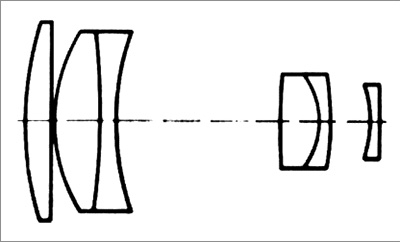
Canon 200mm F2.8 FD:

_________________
If raindrops were perfect lenses, the rainbow did not exist. |
|
| Back to top |
|
 |
cooltouch


Joined: 15 Jan 2009
Posts: 9097
Location: Houston, Texas
|
 Posted: Thu Mar 17, 2016 3:58 am Post subject: Posted: Thu Mar 17, 2016 3:58 am Post subject: |
 |
|
cooltouch wrote:
Koen and Gerald, thanks very much for adding photos and commentary to this thread. Koen, it looks like that 200 SSC is a keeper. Fantastic sharpness. About your 80-200 -- yours is the 2-ring zoom, right? You know, back in the day, that was a very expensive zoom. When Canon came out with the nFD 70-210/4 in the 80s, they continued to produce the 2-ring 80-200/4, but it sold for something like twice as much as the 70-210. So yours is far from being a cheap zoom. Heh. I just had a look on US eBay though and wow! Quite a few of them selling for cheap. I'm so tempted!
Gerald, your comments and photos have rekindled my interest in the CZJ 200/2.8 Sonnars. They were on my list of considerations when I ultimately decided on a Tamron SP 80-200/2.8 LD instead of just a straight 200mm or 180mm. I've really enjoyed the Tamron -- and the tests I showed here give a good idea why. But still, I feel that familiar LBA calling again.  BTW, how would you compare the Contax 180/2.8 (with Contax/Yashica bayonet) to the CZJ? BTW, how would you compare the Contax 180/2.8 (with Contax/Yashica bayonet) to the CZJ?
_________________
Michael
My Gear List: http://michaelmcbroom.com/photo/gear.html
My Gallery: http://michaelmcbroom.com/gallery3/index.php/
My Flickr Page: https://www.flickr.com/photos/11308754@N08/albums
My Music: https://soundcloud.com/michaelmcbroom/albums
My Blog: http://michaelmcbroom.com/blogistan/ |
|
| Back to top |
|
 |
Gerald


Joined: 25 Mar 2014
Posts: 1196
Location: Brazil
|
 Posted: Thu Mar 17, 2016 8:03 pm Post subject: Posted: Thu Mar 17, 2016 8:03 pm Post subject: |
 |
|
Gerald wrote:
Michael,
Your Tamron SP 80-200 F2.8 LD is a great lens. Much more versatile than any prime 200mm F2.8.
The CZJ is a very good lens, mechanically and optically.
Once I had to regrease my copy, and I got the impression that it is an eternal if properly maintained.
Its biggest shortcoming is the weight, almost 1200g, i.e. 50% more than a typical 200mm F2.8.
About the Contax 180mm F2.8, I have no experience with it, but as far as I know it is a good lens but not exceptional.
It is not heavy and focuses down to 1.4m, which is very good for a 180mm lens.
The site slrlensreview.com did a good review of the Contax 180mm F2.8. You may want to take a look at the samples.
Despite the Contax 180mm having a floating element to improve image quality for close focusing distances,
sincerely I was not too impressed by the photo below, where nothing appears really sharp even at F8!
Contax 180mm F2.8 at F8:

EDIT: The picture above is a downsized version for the sake of better presentation of the texts. To see the original image in its full glory, follow the link:
http://slrlensreview.com/web/images/stories/galleries/cz-sonnar-180mm-f28cy/dof/fdof2-cz-sonnar-180mm-f28cy-iso400-s100-f8-180mm.jpg
About the CZJ Sonnar 200mm F2.8
The CZJ Sonnar 200mm F2.8 uses an optical formula that is not too suitable for close-ups or macro photography.
The photo below was taken wide open and 2.2 meters, which is the minimum focusing distance of the CZJ Sonnar.
The focus was on the rose facing the lens.To evaluate the sharpness, look at the fine details: threads and fabrics of the rose.
The result is not spectacular, but IMHO it is a little better than the Contax 180mm.
CZJ Sonnar F2.8 at F2.8 and 2.2m on Sony A99V - full image:

CZJ Sonnar F2.8 at F2.8 and 2.2m - 100% crop:

_________________
If raindrops were perfect lenses, the rainbow did not exist.
Last edited by Gerald on Thu Mar 17, 2016 10:45 pm; edited 1 time in total |
|
| Back to top |
|
 |
Koen Nhz


Joined: 07 Jul 2011
Posts: 84
Location: Antwerp, Belgium
|
 Posted: Thu Mar 17, 2016 10:20 pm Post subject: Posted: Thu Mar 17, 2016 10:20 pm Post subject: |
 |
|
Koen Nhz wrote:
@ Gerald: thank you for your elaborate answer regarding CA and east vs west lenses, your explanation seems very plausible!
And also for the diagram, I couldn't find one for this FD lens, I thought Canon camera Museum used to have them next to specifications, but apparently not anymore.
What you said about zooms versus primes: I still like the quality of some primes better (and the weight), but a tele-zoom is more convenient indeed, for wide to normal lenses I almost never miss the ability to zoom, but for tele, 200mm is often a bit too much (or not enough of course  ) )
About your close-up shot with the Contax 180mm F2.8 at F8: are you sure this is not just movement blur, I noticed that on my Sony I need much faster shutter speeds than on my old 40D dslr (with about the same pixel density) and certainly with longer heavier lenses, for 200mm I try to keep it above 1/400 at least and even above 1/800 if possible, but still, yours seems to be on the edge at 1/100?
@ cooltouch: Your welcome and thank you, the sharpness surprised me a bit, in a good sense, and this lens handles very nicely, it feels much lighter than 700g, especially compared to the (only 50g heavier) 80-200 f/4 SSC wich doesn't balance so well on the A7 imo.
This is my 80-200: http://www.canon.com/c-museum/en/product/fd190.html, it's the 2 ring zoom indeed, I knew it was a very expensive lens when it was new, it costed more in 1976 (100.000 yen) than the 80-200 f/4 L costed in 1985, In fact I think that even translates to more money today than the new 70-200 L lenses?!
But my sample had been waiting in the second hand window of this local shop for more than 3 months at the price of �19, 2 FD 70-210 sold for about �30-�35 in the same time..
The SSC focuses down to 1m btw, so it gives almost 1:3 macro at 200mm!
But I think there is a problem with mine perhaps, there are some (probably almost harmless) small dents in the front glass, but perhaps they came from falling right down on it, because if I look inside the lens from behind and focus on the edges of one of the front group lenses there seems to be a light reflecting ring almost al the way around it, like all of the edges were crumbled off (only like half a mm or so), or perhaps it's the start of separation, or something else, I don't know, but I don't care too much for the price I paid, but wonder how good it might be in perfect state. Below +- 135mm you can't see this edges, when you look through the lens from behind and it give very nice results to about that same focal length, so this might be the reason.
I tried to take a few pictures of it a few days ago, it's not very clear, might try it again with more light..
#1
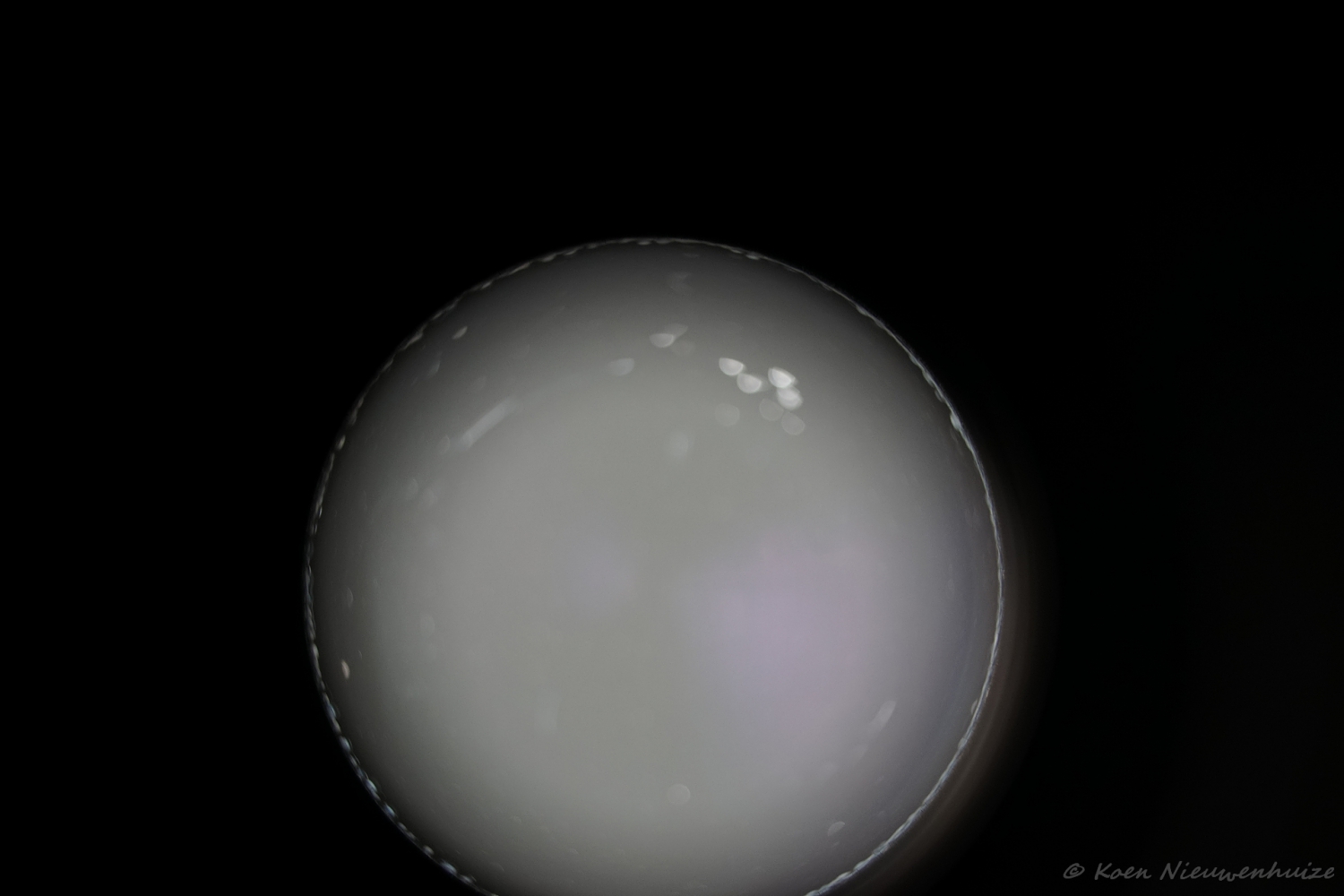
#2
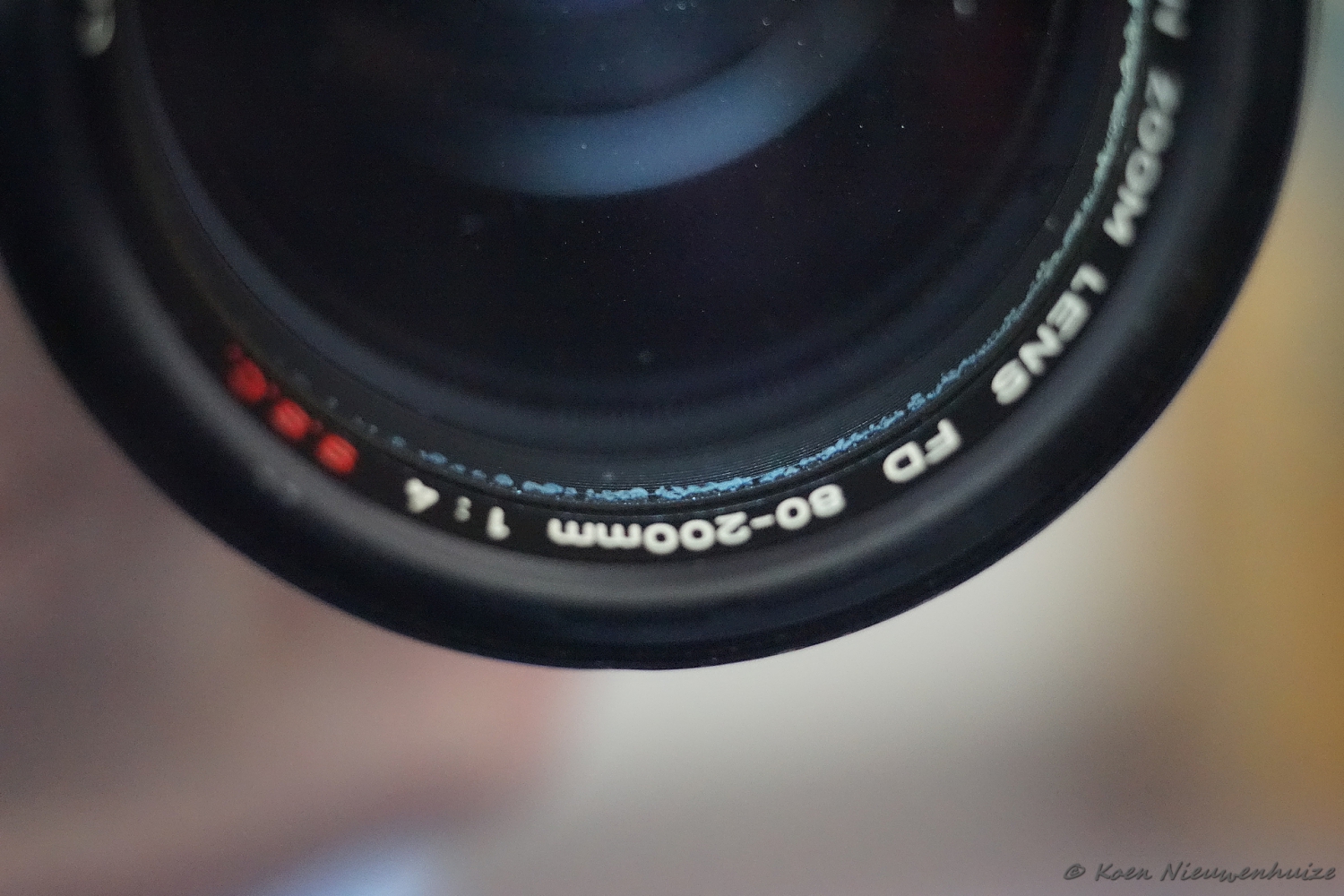
It seems harder than I thought to find a really good 200mm lens, I used to have a 70-200 f4 IS on my 40D (and still have it, somewhere in it's box in a closet) but never really liked it.
One of the best I ever used (and also still have) is an AF Sigma 70-300 APO macro II, very cheap, nasty plastic lens, but very very good image quality from 70-270 mm! But not fast of course (in any meaning, AF, f-stop)
I think the 200 SSC is going to get used a lot, but it's not the best close-up either, the CA becomes more pronounced and sharpness reduced a bit, and 1.8 m MFD could be a bit closer.. but I guess there is always the ability to crop from further, that might work better than extension tubes on this one.. 
Finally one more (full 24Mp) photo with the 2x-B extender, wide open I think, so 400mm f/5.6:
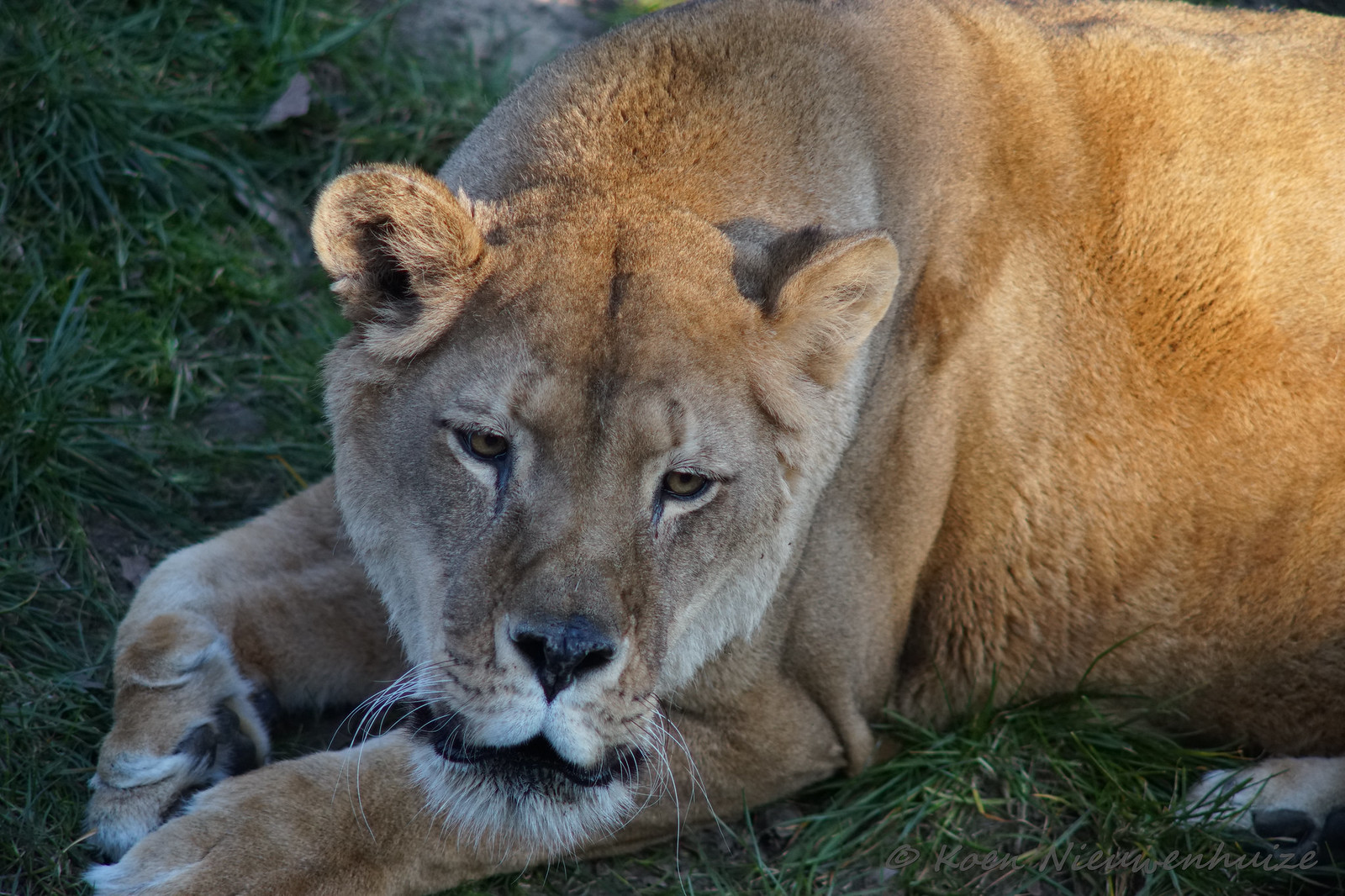
full 24Mp DSC00700_copyright by Koen Nieuwenhuize, on Flickr
It's not the best picture, might have been better if her head was in the sun, but I was quite surprised by the resolution, look at the eyes or hairs on the ears, there is even some moir� at 100%, but of course also quite a lot of CA, but I think this should be removable in PP if you know how to.. 
_________________
Sony α7, 28-70 | Minolta Rokkor 58 1.2 | CZ 35 2.8, 50 1.7, 135 2.8 | Canon 40D, nFD 20 2.8, 70-210 4, 300 4 L, FD SSC: 24 2.8, 35 2.8 TS, 50 3.5 Macro, 55 1.2 ASPH, 100 2.8, 80-200 4, 200 2.8, 500 8 Reflex | Vivitar S1 90 2.5 | Nikkor 105 1.8 | Takumar 50 1.4, 55 1.8, 135 2.5 & 3.5 | Tair 300 4.5 | ... |
|
| Back to top |
|
 |
Gerald


Joined: 25 Mar 2014
Posts: 1196
Location: Brazil
|
 Posted: Fri Mar 18, 2016 1:57 pm Post subject: Posted: Fri Mar 18, 2016 1:57 pm Post subject: |
 |
|
Gerald wrote:
| Koen Nhz wrote: |
| About your close-up shot with the Contax 180mm F2.8 at F8: are you sure this is not just movement blur? |
That close-up shot is not "mine"; it is from the slrlensreview.com site.
I have the impression that there is no movement blur, but I'm not sure.
| Koen Nhz wrote: |
| if I look inside the lens from behind and focus on the edges of one of the front group lenses there seems to be a light reflecting ring almost al the way around it, like all of the edges were crumbled off (only like half a mm or so), or perhaps it's the start of separation, or something else |
In my copy of the Pentacon 135mm F2.8, I also see that type of pattern. They look like yellowish residues of cement. Since they seem to be EXTERNAL to the junction of the optical elements, they don't seem to be caused by separation. In my Pentacon the "ring of Saturn" is stable and have not deteriorated with time, so I stopped worrying about it.
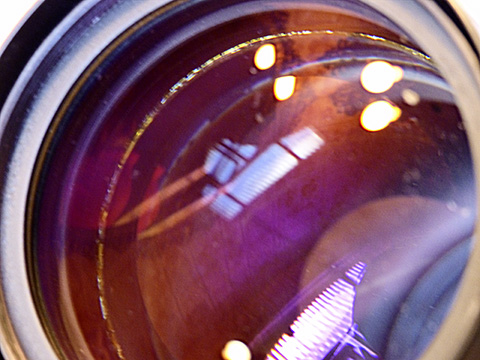
| Koen Nhz wrote: |
Finally one more (full 24Mp) photo with the 2x-B extender, wide open I think, so 400mm f/5.6:
It's not the best picture, might have been better if her head was in the sun, but I was quite surprised by the resolution, look at the eyes or hairs on the ears, there is even some moir� at 100%, but of course also quite a lot of CA, but I think this should be removable in PP if you know how to..  |
Nice picture, it seems sharp to my eyes. I have also tried a 2X teleconverter on my CZJ 200mm F2.8 for an effective 400mm F5.6, but I was never satisfied with the weight, balance and image quality. Much better to use a 400mm F5.6 prime lens instead.
_________________
If raindrops were perfect lenses, the rainbow did not exist.
Last edited by Gerald on Fri Mar 18, 2016 9:15 pm; edited 1 time in total |
|
| Back to top |
|
 |
Pontus


Joined: 18 Dec 2011
Posts: 1471
Location: Jakobstad, Finland
Expire: 2016-08-25
|
 Posted: Fri Mar 18, 2016 2:22 pm Post subject: Posted: Fri Mar 18, 2016 2:22 pm Post subject: |
 |
|
Pontus wrote:
I can't help but wonder how the Contax 100-300 would fare against the competition in this thread at 200mm.
_________________
Follow this link for my FOR SALE list (partially updated 19.11.2015) |
|
| Back to top |
|
 |
cooltouch


Joined: 15 Jan 2009
Posts: 9097
Location: Houston, Texas
|
 Posted: Fri Mar 18, 2016 11:47 pm Post subject: Posted: Fri Mar 18, 2016 11:47 pm Post subject: |
 |
|
cooltouch wrote:
Pontus, your wondering made me wonder about a couple of zooms I own. I realized I own two zooms that zoom out to 300mm that contain special glass: I have a Nikon 70-300mm f/4-5.6 AF D ED and a Tokina 100-300mm f/4 SD lens. So I decided to do a quick little test. This isn't meant to be thorough at all, but at least gives a glimpse of their capabilities. And I'm sure your Contax will probably score just as highly if I had one to try here.
So, I found a nice yellow rose blooming beside our house, dragged out a stout tripod and took these two lenses, along with my Tamron 80-200/2.8 LD -- as a control -- and got busy.
I used my NEX 7, set to ISO 100 and I set each zoom to 200mm and f/8. The point of focus was those tiny yellow thingies in the center of the rose. It appears the Tokina's zoom collar slipped a bit because its image is noticeably larger. I didn't notice this until I was back at the computer, though, and I wasn't gonna go reshoot over this small difference.
In the following images, no PP was done other than resizing for comparison here. The first image was shot with the Tamron and is shown just to give you the entire frame. The second image is a composite of the three lenses, all set to f/8. As you can see, they are all tack sharp and there isn't really a dime's worth of difference between any of them.


_________________
Michael
My Gear List: http://michaelmcbroom.com/photo/gear.html
My Gallery: http://michaelmcbroom.com/gallery3/index.php/
My Flickr Page: https://www.flickr.com/photos/11308754@N08/albums
My Music: https://soundcloud.com/michaelmcbroom/albums
My Blog: http://michaelmcbroom.com/blogistan/ |
|
| Back to top |
|
 |
Pontus


Joined: 18 Dec 2011
Posts: 1471
Location: Jakobstad, Finland
Expire: 2016-08-25
|
 Posted: Sat Mar 19, 2016 6:12 am Post subject: Posted: Sat Mar 19, 2016 6:12 am Post subject: |
 |
|
Pontus wrote:
Interesting. But I can't say that I'm surprised about the Tokina. I had the AF version and it was wonderful, some PF though if I remember correctly. Another sleeper (also AF) is the Sigma 100-300 which is absolutely top notch.
_________________
Follow this link for my FOR SALE list (partially updated 19.11.2015) |
|
| Back to top |
|
 |
|
|
